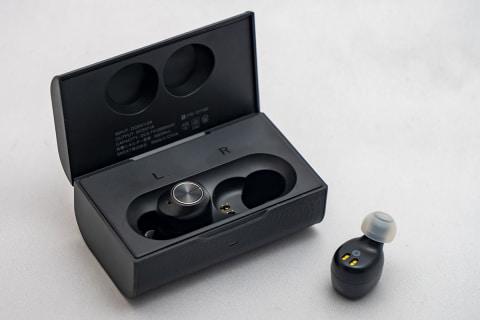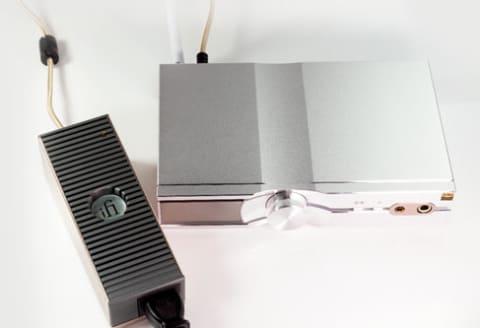The product genre of complete wireless earphones (TWS) brought by Apple, which has established various new common senses in digital life, has quickly become one of the main players in the audio industry. .
TWS, which transmits via Bluetooth, has not been on the table much in the context of sound quality, but Mr. Asakura says that not only convenience but also sound has improved since coming here. TWS is finally becoming interesting for audio hobbyists.
――The nationwide state of emergency was lifted in May, and society is beginning to shift to a phase of returning to normal. As music accompanies you when you walk outside, this issue of Enmacho will feature the completely wireless earphone (TWS) genre, which has become all the rage in recent years.
Asakura: Looking back, I didn't see any mention of TWS itself in this corner. TWS has a big presence in the market now, but there is a trend that portable audio has been downsized from wired headphones to wired earphones, and here we are showing the evolution of wireless, and "completely" wireless. Moreover, there are many with a noise canceling function that seems to emphasize walking around town. As an enma book that emphasizes trends, you can't help but pick this up. So, this time, I ordered about 5 types of TWS products that are currently selling well from 3 manufacturers and listened to their sounds.
The first thing we have to confirm is that TWS has strict acoustic requirements. Since it is a genre that sells small and light wearing comfort, we cannot afford to buy a diaphragm (diaphragm) diameter, and even a large diameter of 10mm is not easy to use. What does this point fundamentally mean for the reproducibility of sound?
Related to this, the housing has to be packed considerably, and the way the chamber (air chamber) is perceived is quite different from the conventional one. Due to the problem of battery duration, the power supply, which is an important factor in creating sound, cannot be strengthened so much. And the biggest problem is that the compression format of Bluetooth is standard. Although it is aptX, basically there is no difference in lossy compression of the source.
In this way, TWS is a genre with many difficulties in audio design. Even if those problems are subtracted, it's still convenient, so it's a hot seller. The biggest point of dissatisfaction with earphone/headphone listening is that the wire does not get entangled.
Audio has always had a history of being inversely proportional to convenience and sound, and having to choose between the two. Whether it's stationary or portable, the more you pursue convenience, the more careless the sound becomes. There may be manufacturers who are doing their best even in such difficulties. With such expectations, I decided to feature the latest trends in audio this time.
Let's touch briefly on the audition environment. My player uses an OLED AQUOS smartphone with a portable version of foobar2000 installed. All sound sources are high resolution (although the sound output is not high resolution), and the Carpenters' "Yesterday Once More" is the first to listen to the vocals. The highlight is the harmony of Karen and Richard, and the texture and thickness of the instruments.
I also listened to one of my standard reference recordings, "Mozart; Symphony No. 41 in C major 'Jupiter'" performed by Eugen Jochum/Boston Symphony Orchestra. It is a sound source selected from the compilation "Listen to Deutsche Grammophon & Decca on DSD selected by Reiji Asakura" released last year and has been very well received. Even if you listen to the music purely, there are many highlights in the performance, such as the sense of scale of the orchestra, the appearance of details, and the overtones of the strings.
――What you should be careful about when auditioning TWS is that you should not use lossy compression sound sources such as subscription services as reference sound sources. The idea that "the sound will be compressed at the stage of Bluetooth transmission anyway, and the sound output will not change even if the original compressed sound source is used" is a big mistake. If you listen to the same song and compare it, you can hear that the compressed sound source (especially the subscription one) has noise at a level that "anyone can understand". Regardless of purely enjoying music, these sound sources are not suitable for listening to different sound quality.
As a reference, it is still recommended to prepare uncompressed WAV sound source ripped from CD or purchased/downloaded high-resolution sound source.
Asakura: Well, it's common for things that seem trivial to be the cause of discomfort, so let's not overlook them.
First of all, we will take up three models of "RZ-S30W", "RZ-S50W", and "EAH-AZ70W" released by Panasonic. Until now, Panasonic has been watching the TWS market quietly, but it has been fully prepared to rush into the market. So, I can't say where, but I compared it with a "certain hot-selling product" that is highly rated in the market and is treated as a reference.
By the way, the noise canceling performance is not included in the evaluation this time. However, Panasonic's TWS has a reputation for being excellent here. I listened to each model in advance at CES earlier this year, and even then I felt that the noise canceling was good, and it certainly felt like the level was high. That's why I listened with the noise canceling ON this time.
Panasonic's keyword is "clear and clear." Take it out clearly and push it out to the details. This feeling is common to all models. The products are classified according to the difference in texture and quality. It can be said that the marketer and technology are fused, the level of manufacturing and quality is skillful, and the price desired by the market segment is well balanced.
--To put it bluntly, "The higher the machine, the better the sound." If you say it's easy to choose, it's easy to choose.
RZ-S30WAsakura: Let's listen to "RZ-S30W" first. This is a strategic machine that expands the base of the brand as an entry model. The "EAH-AZ70W" given the Technics brand is in a higher place than the Panasonic brand, and the price is naturally given. However, in terms of cost and performance, the two models that sell well are this product with the Panasonic brand and the "RZ-S50W". In that sense, it had a very marketing feel to it.
Frankly, the sound is completely different from the “certain best-selling product” I mentioned earlier. This is very impressive. There is not a sense of resolution over there, but rather a fluffy feeling of swelling, and if anything, it feels like you can listen to it with a sense of volume in the bass. On the other hand, this is clearly heard in high-pitched tone. Paradoxically, the bass is modest, and this is taken advantage of for a clear, crisp, and crisp feel. I feel a sense of clearness and good energy.

On the other hand, the bass is a little lacking, so the high key balance is closer to the mid-high range. Even though there is a problem with the bass, it sounds like a lot of information is coming out. .
Yesterday once more is clear, but the vocals are a little thin, and the sound harmonies are hard. In Jupiter, there was also a high rise and metallic place. Including this, the sound trend in the market, and when compared with a "certain hot-selling product", we can judge that it is a model that is conscious of the market and incorporates Panasonic's originality well.
An overseas model that Mr. Asakura listened to at CES at the beginning of the year. Unlike the domestic model, the model number is three digitsAsakura: Next is the middle model RZ-S50W. This is Panasonic's skill in making sounds. Knowing the grading properly, I can feel the gratitude that the model number has increased from 30 and it has become a high class. When users consider purchasing, if they listen to the entry model 30 first, they will have the impression of "well, this is what it is". If you listen to 50 next, it will be "Oh, it's pretty good." In this way, the difference from 30 is given, and the differentiation within the company at the store is clearly shown. I think that Panasonic's TWS lineup is a fusion of that aim and the skill of making marketing sounds.
RZ-S50WIn terms of sound, first of all, the view is better than the 30, and you can see what kind of sound is in what place in the sound field and how it resonates. Karen's vocals are characterized by being very refreshing, clear and relaxed, and I expressed this point as "high key" in the previous 30. However, at 50, the emphasis is diluted and refreshing. Such a relaxed feeling comes out due to the high frequency knob.
If I give a severe opinion, I feel that I want a little more content in the sound. Karen's voice is good, but I wish she had more clarity in her harmonies with Richard. On the other hand, it gives the impression that the surface of the sound has been beautifully polished. 30 had the impression that the wax was rough, but here, the texture of the wax is finer, and the brilliance is smooth from glitter to shiny.
I was pretty impressed with another song, Jupiter. This performance has the classic wing arrangement with the bass and second violin on the right channel and the first violin on the left. I felt that the feeling of bass and treble on the left and right, and the difference between the sounds of the first and second violins came out better than the 30.
However, it will be a little difficult to listen to the orchestra with this. "A certain best-selling product" seemed to emphasize the volume of the bass, but the sound of this product seems to be the antithesis to this. As a result, the volume of bass is slightly lacking. If it's about the Carpenters, the formation is small, and the bass is about bass drum and bass, but when it comes to a full orchestra like Jupiter, it's undeniable that the acoustic bass is lacking.
However, the overtones of the 1st violin are well expressed. This performance is very stable, and the American orchestra has a more splendid sound than the European one, but I felt that such a brilliance was expressed in its own way.
This is also an overseas model with a three-digit model numberAsakura: Next is the Technics brand "EAH-AZ70W". Although the model number has increased in steps of 30, 50 and 20, the technics have been significantly upgraded. Impressively, it's about "85" instead of "70". In contrast to Panasonic, a mass-market brand, the Technics brand is a distinctly separate field for audiophiles.
Technics brand "EAH-AZ70W"Of course, the sound also follows the brand concept, and while Panasonic produces a popular sound, Technics aims for a full-fledged sound that will impress enthusiasts. That is the first difference. In terms of past products, for example, even if you take an integrated audio system like a radio cassette player, the sound creation point of the Panasonic brand has not been heard so much as an OEM. On the other hand, the OTTAVA S "SC-C50", which Technics put its heart into, has a remarkably good sound thanks to advice from the Berliner Philharmoniker. In that sense, TWS is also very different from 30/50 that sells volume and 70 that includes both price and technology.
One thing, unfortunately, this one doesn't have a ferrofluid driver. This driver introduced in the high-end earphone "EAH-TZ700" was highly evaluated for its low frequency reproducibility. It would be a shame not to have it. However, conversely, I would like to evaluate the fact that ``the sound came out so far without adding that''.
Regarding this product, when I checked it at CES, my impression was that it was not perfect. However, after listening to the product model this time, my impression has changed considerably. At CES, I was like, "The noise canceling is good, but what about the music?"
Wired high-end earphone "EAH-TZ700"First of all, Carpenters, it has a high degree of transparency. As for the previous two models, although they had power and outline in the mid-high range, they did not reach the point of transparency. In the Technics brand 70, we have it. Transparency is an important point when listening to Karen's songs, and clear texture is also a feature of Karen's singing voice.
One more thing, the fineness of grain is good. The low-end models are characterized by their liveliness that makes them sound crisp and clear, so the coarser ones sound more energetic. However, since the basic performance has been improved, even if the vocals are finer, the energy will not be lost. This is a clear advantage over the Panasonic brand.
Furthermore, the stability of the bass was also good. This sound source creates a low-pitched sound with the bass drum and bass, but compared to the lower model, the amount of sonic information in the parts such as the sound of hitting the bass drum and the movement of the bass is outstanding. It was also good that the sound image, especially the vocal sound image, was localized in the center and the outline came out clearly. The two Panasonic brand models don't care that much, basically, "Let's go energetic!" On the other hand, the Technics brand clearly expressed the structure and structure of the sound, and the sense of position and stability of the sound image in the sound field, without any emphasis. In that sense, I feel that my vocabulary has increased. This is a high resolution, or rather, it fits the proposition of the current market.
What about Jupiter? Until now, I felt that the classical sound was like Paul Mauriat, with electric guitars. On the other hand, this product has an acoustic feel. There is also graininess, and there is a naturalness that is not an electric mechanism. It's not just gorgeous, it's calm and colorful.
If you're going to make an order, I'd like to cut into more details. It would have been better if we could see more of the individual notes that make up the harmonies when we played in ensemble. But not the Panasonic brand. Significantly different. There is a technics brand. It has a clear and clear sound from the beginning, but it also creates a world of sound that is isolated with a sense of graininess and transparency. Feel of a material should be raised more, too.
--Well, can I be honest? I thought, "Are you going to put a 'technics' brand on this sound?" I don't think it's a bad sound at all, but "I can't see the brand from the sound" and "there's no Technics sound". I have a romanticist (storyteller) idea in a sense, and in that way, a brand is a condensed story. In recent years, you must have a philosophy that you have built up over time, such as seeking guidance from the Berliner Philharmoniker.
However, I didn't see such a "technics story" in this sound. It is a technics brand of the world, not a horse bone. I felt that I wanted the brand history and background music culture to be visible through the sound.
Asakura: I see, I can understand why Amano-kun thought so. It's true that I didn't really feel the dignity and authenticity of Technics, or the authenticity and naturalness of Technics, but in a sense, I thought it was Technics. Isn't it an extension of the brand concept to incorporate the new field of TWS? It's better than the Panasonic brand because it feels like they worked hard, but I'd like to see a bit more of a high-end feel where the music comes to life naturally.
This is the strong point of the magnetic fluid driver that I mentioned earlier, and the original Technics sound is probably the wired TZ700 that uses this driver. This is a difficult area for TWS.




